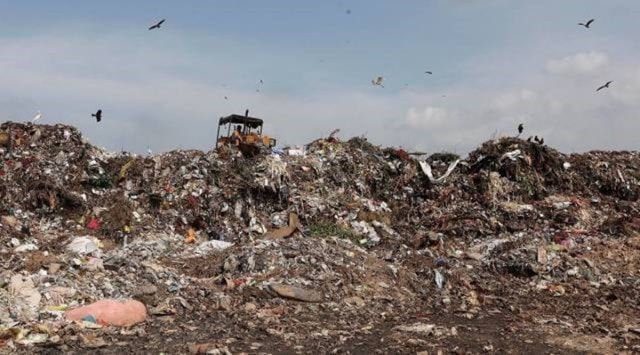L-G Saxena-headed panel orders to start early morning waste collection in Delhi
Officials told to submit daily reports accompanied by photographs with regard to the management and disposal of solid waste from Friday.
 Landfill site at Ghazipur (Express/file)
Landfill site at Ghazipur (Express/file) A high-level committee headed by Lieutenant Governor Vinai Kumar Saxena has decided to deploy fire tenders at Delhi city’s three landfill sites and more vehicles for early morning waste collection which began on Friday.
In its first meeting held on April 25, it asked the officials to submit daily reports accompanied by photographs with regard to the management and disposal of Municipal Solid Waste (MSW) from Friday.
According to LG House, the committee appointed by the National Green Tribunal has issued a slew of directions regarding a revised ward-wise action plan and asked the Municipal Corporation of Delhi (MCD) to submit the name of the officer responsible for the task so as to achieve cent per cent segregation of waste within the next 10 days.
The committee has asked the authorities to immediately start early morning cleaning and waste collection starting at 5 am on a pilot basis in the West Zone and the Dwarka area, increase the number of vehicles to lift waste and submit daily reports with photographs, and ensure that all waste collection vehicles were GPS-tagged and monitored.
The Delhi Pollution Control Committee (DPCC) was instructed to assess the solid waste dumped alongside the railway tracks and ensure that they are cleared by the Railways in the next 15 days. The municipal corporation was asked to submit a revised action plan for processing the solid waste taking into account futuristic waste generation statistics within a week.
The panel directed the DPCC to immediately start an intensive drive to close down all polluting industries in coordination with the agencies and local bodies and submit a daily report to it. To check landfill fire incidents, directions were issued to station fire tenders at each of the landfill sites immediately.
With regard to the daily generation of 11,000 MT of fresh municipal waste, the high-level committee was informed that the current capacity of disposing of waste was 8,000 MT resulting in the excess 3,000 MT of fresh waste being dumped on the three sites daily.
“In this regard, while the 4 operational waste-to-energy plants were consuming about 6,800 MT every day, another plant with a capacity of 3,000 MT per day was in the offing along with two more waste-to-energy plants to take care of prospective fresh municipal waste that will be generated,” officials added.







